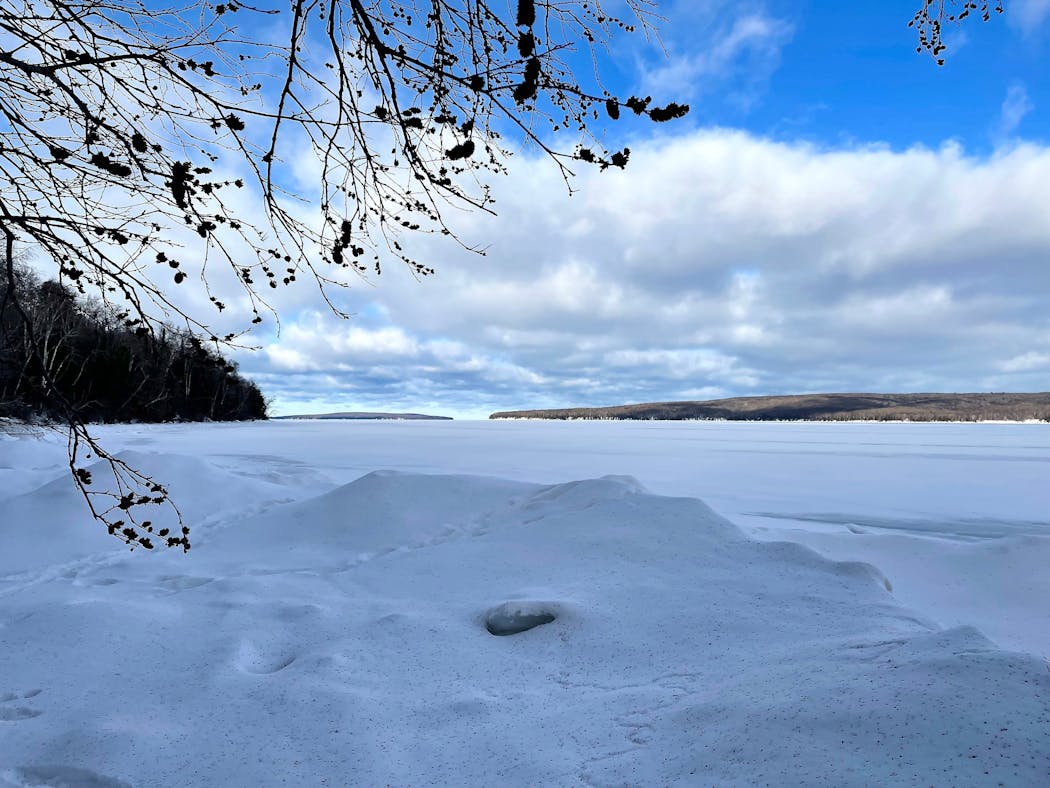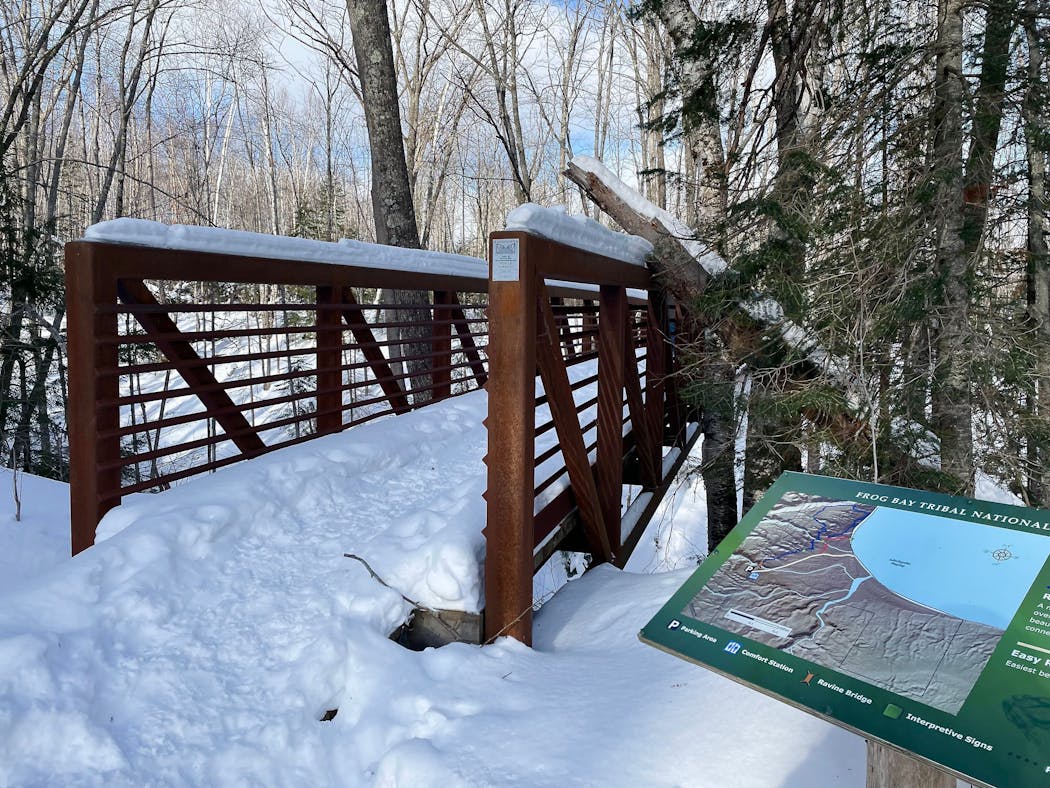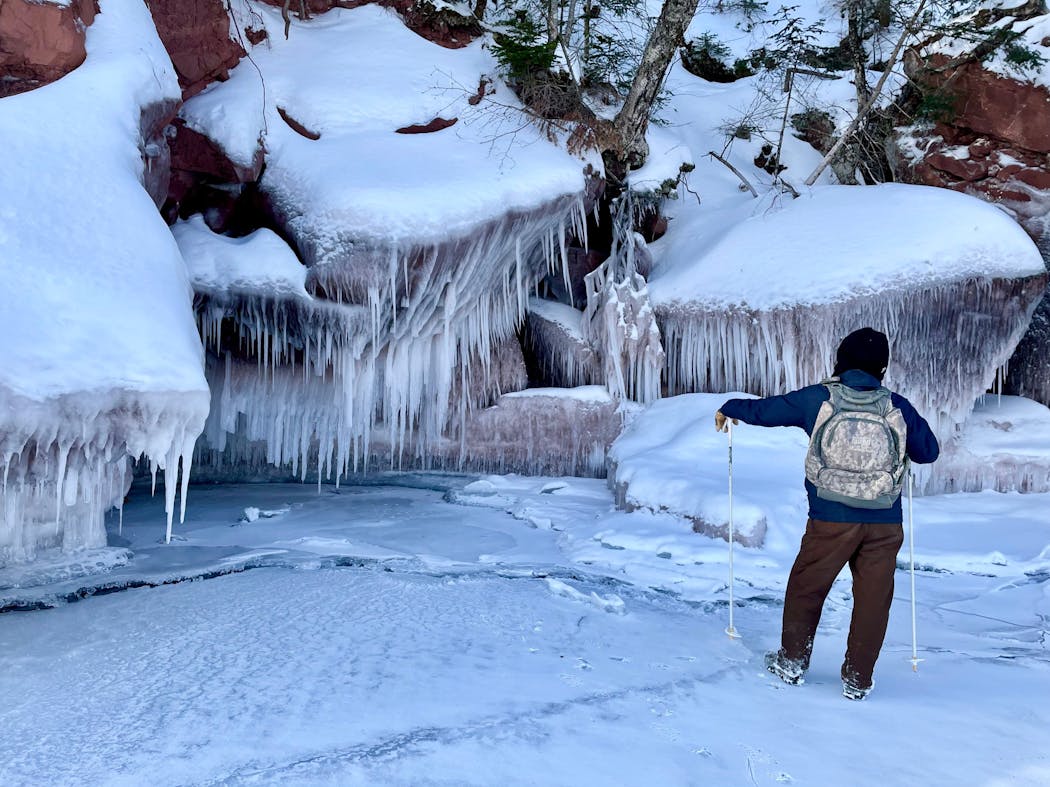Our snowshoes squeak in the snow as we tramp along the winding Ravine Trail, which unspools down to the Lake Superior shore. The scenery is gorgeous — a veritable winter wonderland — and the frosty air carries a peaceful vibe.
My husband and I pause before a stand of paper birch, or wiigwaas in Ojibwe. An interpretive panel notes that these versatile trees were traditionally used by Indigenous nations to craft everything from canoes and baskets to sleds and flutes. A smattering of smaller signs along the trail give us a crash course in Ojibwe terms, such as migizi (bald eagle) and makwa (bear).
This pristine land is Frog Bay Tribal National Park, the country's first tribally owned or controlled park that's open to the public. The Red Cliff Band of Lake Superior Chippewa created the park on Wisconsin's Bayfield Peninsula in 2012, after reacquiring an 89-acre parcel. In 2017, a second, 86-acre plot was procured, doubling the park's size.
To the casual observer, Frog Bay may appear to be simply another pretty piece of land. But it contains a rare boreal forest ecotype, coastal wetlands and a three-quarter-mile slice of undeveloped Lake Superior shoreline. It's also home to the mouth of Frog Creek, some 90 bird species and wildlife such as bobcats, black bears and wolves.
Now we're following the Beach Trail, which bumps us onto the snow-covered sands at Frog Bay proper, a tiny scallop in the Bayfield Peninsula shoreline. Here we're treated to a rare, impressive view of five of the 22 Apostle Islands: Bear, Oak, Stockton, Michigan and Hermit. The sight is enhanced when a bald eagle silently soars overhead. Or should I say, a migizi.
A new kind of park
The idea to create a tribal national park emerged after the couple who owned the tract reached out to the Red Cliff Band. The aging owners wanted the property to remain undeveloped, so they donated half of the land value to the tribe. The other half was purchased by the National Oceanic and Atmospheric Administration through a land conservation program.
"The previous landowners took really good care of the land," says Gabrielle VanBergen, deputy administrator of the Red Cliff Treaty Natural Resources Division. "So the tribe decided to share it with more than the tribal community by creating a tribal national park."
But that doesn't mean they created a mini-Yosemite, filled with tourist amenities. A 1.7-mile network of paths circles the park, but that's about it as far as infrastructure. That's intentional, says VanBergen, as the park's main purpose is to protect and preserve the land for future generations, and to allow visitors to immerse themselves in nature.
"As the park evolves, we'll probably do more interpretive signage," she says. "But we don't want to go too crazy with signs. We want to give people a sense of place so you can acknowledge the place you're visiting, and really take in the incredibly long, long history this land has had."
Now this novel idea is spreading. In 2020, the Iowa Tribe of Kansas and Nebraska announced it will create the 444-acre Ioway Tribal National Park. The spot overlooks a historic trading village on the Missouri River used during the 13th to 15th centuries, and includes three burial mounds.
VanBergen says she's also met with a member of the Blackfeet Nation about creating a tribal national park in northwestern Montana, bordered by Glacier National Park.
"A lot of visitors who go to Glacier have to travel through Blackfeet lands, so they're looking to be a part of the discussion, not just a pass-through area," VanBergen says. "So many tribal lands across the nation have national parks next to them, I imagine this will be a growing phenomenon."
Spiritual crossroads
Indeed, the Red Cliff Band is also working closely with the adjacent Apostle Islands National Lakeshore to ensure that their voice is heard when interpreting the area's history. One day, the tribe may even co-manage the national lakeshore with the National Park Service.
Frog Bay and the Apostles have much significance to the Anishinaabe, a broad group of Indigenous peoples that includes the Lake Superior Chippewa. According to Anishinaabe oral history, their East Coast ancestors were called to move here by a prophet, a journey that lasted hundreds of years. Once on the shores of Lake Superior, this spot became their historical, cultural and spiritual crossroads.
Every winter, Red Cliff member Travis Barningham leads tours of the ice caves of Red Cliff Bay, about a three-mile drive from the tribal park. Since access to these caves lies on tribal land, visitors can view them only with a member. We'd signed up for a tour earlier in the day, as the more famous Apostle Islands ice caves were closed due to unsafe ice. It turned out to be a great prelude to Frog Bay.
As the three of us trekked along the rocky shoreline, festooned with glittering ice formations, Barningham doled out snippets of Red Cliff history and tradition. One of my favorites: Whenever Barningham spots a migizi, he doesn't see an eagle, but his ancestors.
"Seeing a migizi reminds me that my brother, mother and father are watching over me," he said. "It's like good luck."
And if Barningham has tobacco on hand, he'll place some on the ground to thank the Creator for letting him live another day.
After a day spent exploring Red Cliff and Frog bays, thoughts of sprinkled tobacco, soaring eagles and ancient Anishinaabe swirl through my mind. As we head back to the car, the land suddenly looks different. Still pretty, but animate. Like it's whispering tales from the past, hoping someone will pause and listen.
Melanie Radzicki McManus is a travel and adventure writer. She lives near Madison, Wis.
Singing, ceremonies and straw hats: Olympics opening ceremony in Tahiti centers Polynesian culture

Three 101-year-old friends recall fond memories in 1940s Alexandria
Celine Dion makes musical comeback at Paris Olympics with Eiffel Tower serenade






